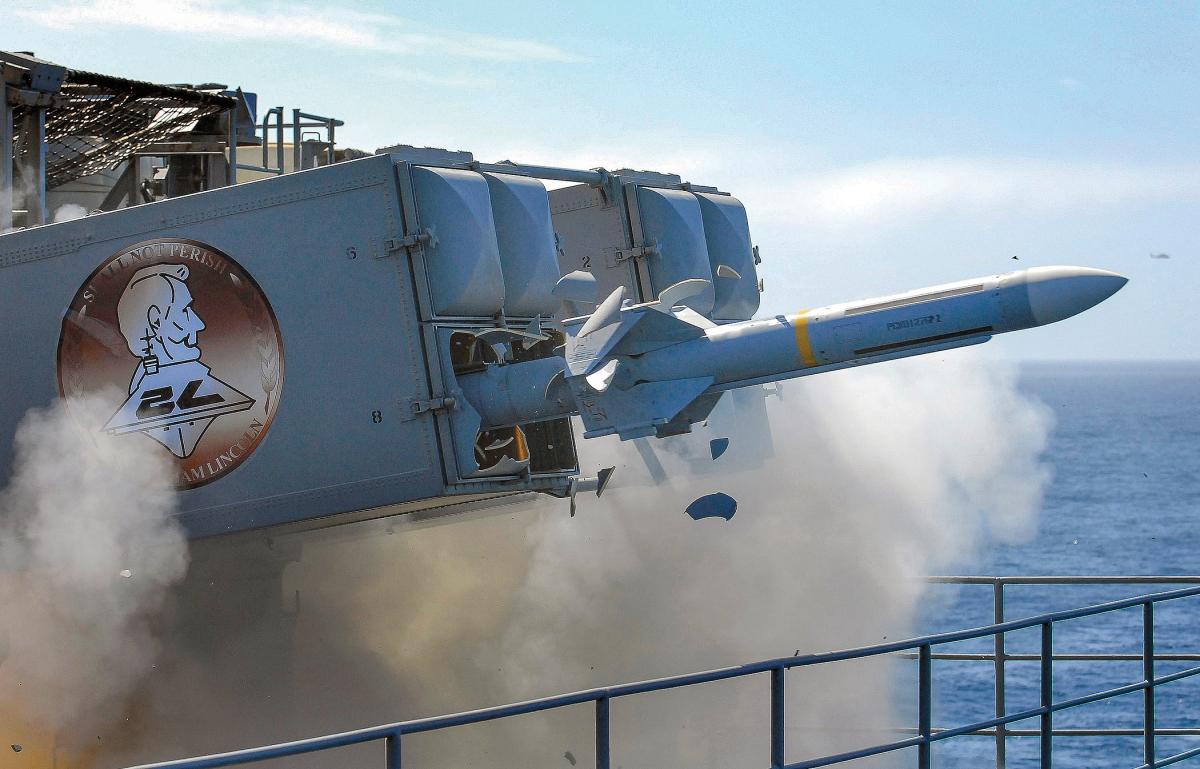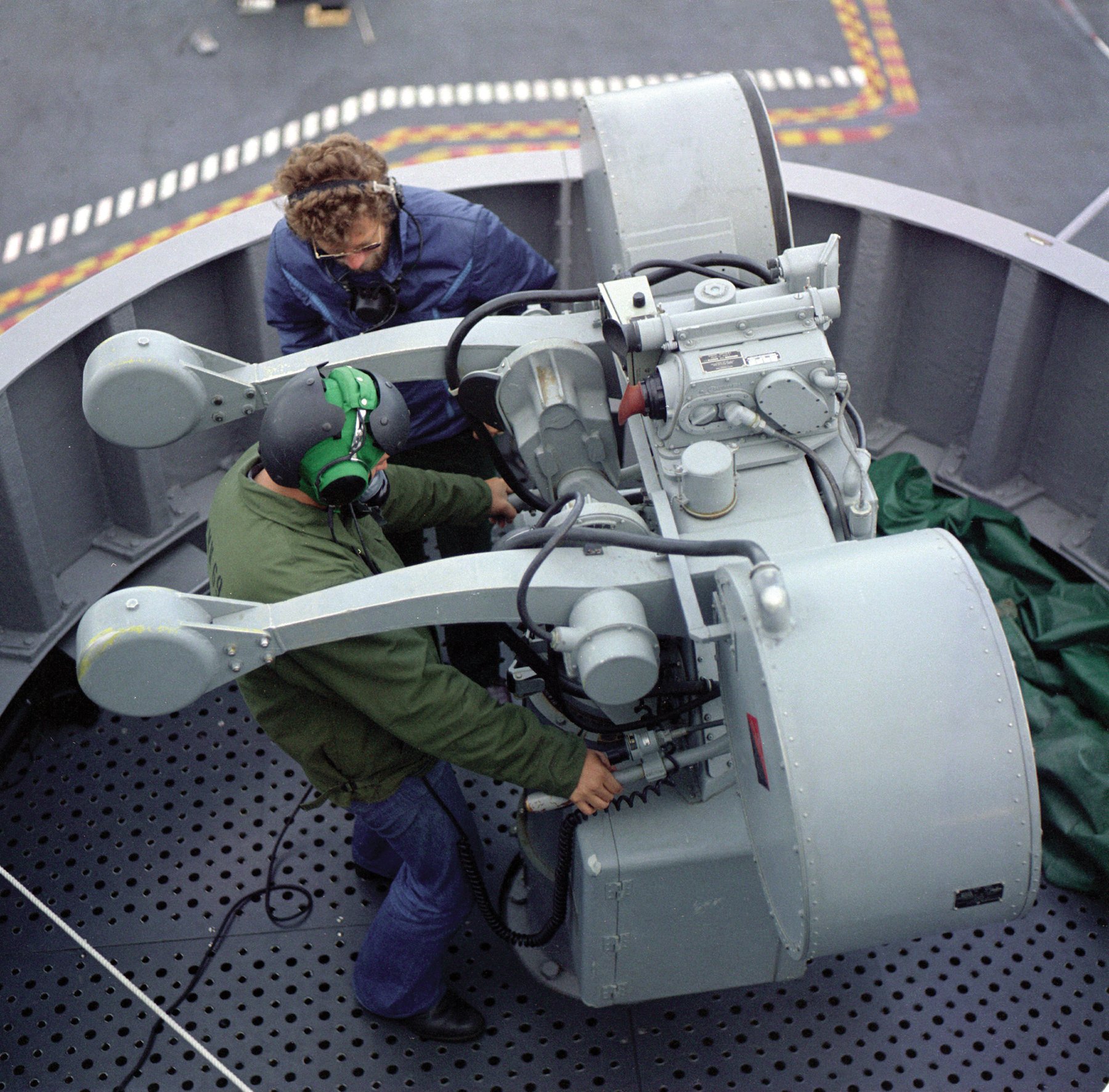The U.S. Navy began working with the Johns Hopkins University Applied Physics Laboratory (APL) in the early 1960s on a program called the basic point-defense missile system (BPDMS) to defend against the Soviet Navy’s Styx antiship missile. The Navy initially planned to adapt the U.S. Army’s MIM-46 Mauler system for use at sea, but after the Army canceled the program in 1964, the Navy turned its attention to the General Dynamics AIM-7E Sparrow air-to-air missile. (See “Armaments & Innovations,” December 2017, for more on the Sparrow’s development.) Redesignated as the RIM-7E Seasparrow, the missile became the main component of the Navy’s BPDMS.
The first version—essentially an unaltered AIM-7E—was fired from a Mk 25 box launcher, a modified Mk 16 antisubmarine rocket (ASRoc) launcher. It relied on semiactive radar homing for guidance, directed by a Mk 115 radar illuminator, which looked like two large searchlights. An operator followed voice commands from the sailors manning the ship’s search radar to aim the illuminator manually. The launcher would follow its motions automatically, so that the missile would see the signal reflected by the target.
A prototype of the Seasparrow Mk 25 trainable launcher was installed on board the USS Bradley (DE-1041) in February 1967. Extensive testing conducted between May and September revealed a number of problems, and the system subsequently was removed from the ship.
The RIM-7E was far from an ideal weapon. Its rocket engine was designed with the assumption that it would be launched at high speed from an aircraft and therefore was optimized for a long cruise at relatively low power; it lacked the high acceleration needed to intercept sea-skimming targets. Its control surfaces were mounted in the middle of the fuselage, presenting another problem: They were optimized to control flight during cruise. This made the missile less maneuverable, reducing its utility as a quick-reaction weapon. The wings, which could not be easily adapted to fold, necessitated a large launcher that took up critical deck space.
The sinking of the Israeli destroyer Eilat by a Russian antiship missile on 21 October 1967 emphasized the need for effective defenses against antiship missiles. This led to a 1968 joint development program with three NATO allies (Denmark, Italy, and Norway) for the NATO Seasparrow Surface Missile System (NSSMS). The Raytheon Company, now prime contractor on the AIM-7 Sparrow program, received a development contract in September 1969.
By the beginning of 1972, Raytheon had upgraded the AIM-7E Sparrow to the -7F model by replacing the older missile’s analog guidance system with a smaller, solid-state version that could operate with pulse-doppler radar. This allowed the warhead to be moved forward of the midbody-mounted wings from its former position in the rear. This in turn made room for the installation of a larger, dual-thrust engine that quickly accelerated the missile to high speed and then settled to lower thrust for cruise. The AIM-7F missile was modified further to perform better at sea and became the RIM-7H.
In March, an engineering prototype of the NSSMS was installed on board the USS Downes (DE-1070) for testing at sea. Both the contractor’s demonstrations and the Navy’s technical evaluation conducted in April of that year were successful, with 80 percent of the intercepts falling within the missile’s specified performance envelope. The first production NSSMS was installed on board the Royal Norwegian Navy ship Trondheim in mid-1975.
A major missile upgrade occurred in 1983. The new RIM-7M model received a monopulse radar seeker and a computerized guidance system that also included a simple autopilot. This permitted the missile to continue flying toward the last-known target location even with the loss of a signal, allowing the launch platform to break radar lock for short periods while the missile was in flight. The modifications improved performance against low-altitude sea-skimming targets as well. A final variant, the RIM-7P, with a new radar fuze and an uplink to the autopilot for midcourse guidance updates, entered service in 1994.
A typical modern Seasparrow battery consists of eight missiles housed in a Mk 29 rapid-reaction, lightweight, trainable launcher; a Mk 23 target acquisition system; and a Mk 95 fire-control radar to illuminate the target. All are controlled by a Mk 91 computer fire-control system that automates target acquisition and tracking, trains the launcher, and generates missile orders.
A Seasparrow system is activated when a ship’s air-search radar or the Mk 95 director detects a target. Charles L. Roe, then–NSSMS project manager for the APL, wrote in a 1991 issue of The Johns Hopkins APL Technical Digest that once the target is detected:
[the director] is stopped, the ranging and angle-tracking modulations are turned on, and tracking begins. If the target signal fades during track, the computer will coast the system in range, bearing, and elevation until the target signal returns.
During track, the time of missile flight to the target is computed. If the target course will bring it within range at some future time, the operator is alerted that the target will be engageable. If it is within range, he is alerted that the target is engageable.
Shortly before a target becomes engageable, the launcher is automatically assigned to the appropriate fire-control radar. It is aimed at the predicted intercept point and adjusted for the optimum trajectory, and the necessary missile orders are continuously calculated and provided. In the automatic mode, a salvo is fired when the target becomes engageable.
During the firing sequence, the rocket motor is armed; the missile self-tests, tunes to the illuminator frequency, and reports that it is ready; and the motor is ignited. In the semiautomatic mode, all operations are identical, except that the fire command is issued by the Firing Officer.
The RIM-7P continues in production and service, but it is the final iteration of the original missile. Raytheon’s RIM-162 Evolved Seasparrow Missile (ESSM) shares little beyond a name with the original missile, but it does use many of the -7P’s existing shipboard support components. It represents a radical redesign—bigger, faster, and more capable against highly maneuverable supersonic targets. The ESSM was first delivered in 2002.





